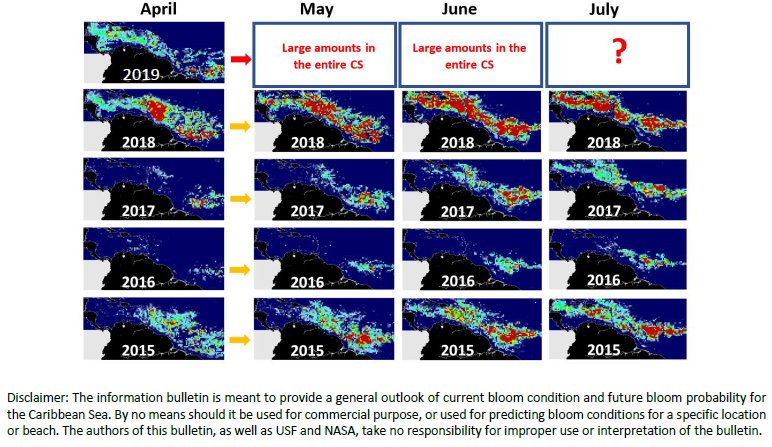The maps above show Sargassum abundance, with warm colors representing high abundance. On Feb 28th we predicted that during March 2019 large amounts of Sargassum would continue to be found in the entire Caribbean Sea (CS) and around Loop Current (LC), and during April 2019 the amount of “new” Sargassum transported from the Central West Atlantic (CWA) to the CS would decrease. Observations during March and April 2019 confirmed this prediction. Following the pathway of the LC and Gulf Stream, Sargassum beaching events have also been reported along the east coast of Florida during both March and April 2019. In April 2019, large amounts of Sargassum are found in nearly the entire CS except nearshore waters along Venezuela and Columbia. In the CS, the amounts are even higher than the historical record in 2018 for the same month.
Looking ahead, because the amount of Sargassum in the CWA in April 2019 is considerably lower than in April 2018, the amount of Sargassum transported from the CWA to the CS (i.e., “new” Sargassum to the CS) during May – June 2019 may be lower than in May – June 2018. However, this transport will still be higher than most of the previous “Sargassum years” during the same months. Furthermore, because of the local growth and already high amount in the CS, the amount in the CS in May – June 2019 may even be higher than in April 2019 and comparable to or even higher than in May – June 2018 (historical record). Meanwhile, the transport to the Gulf of Mexico and east coast of Florida will continue, meaning that beaching events along the east coast of Florida will also continue. The exact Sargassum amount, timing, and location of the beaching will depend on local ocean circulations and winds.
Although it may be too early to predict the situation in summer 2019, because in the central Atlantic the amount of Sargassum in April 2019 is still one of the highest in history, large amounts of Sargassum (comparable to the 2nd largest amount in summer 2015 or higher) in the CS and Gulf of Mexico are a high possibility. More updates will be provided by the end of May 2019.
More information and near real-time imagery can be found under the Sargassum Watch System (SaWS, https://optics.marine.usf.edu/projects/saws.html).
Sargassum outlook update, by USF Optical Oceanography Lab – April 2019 update



